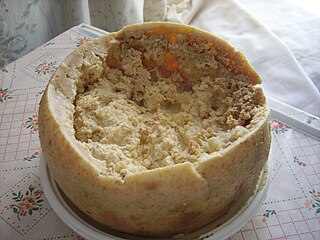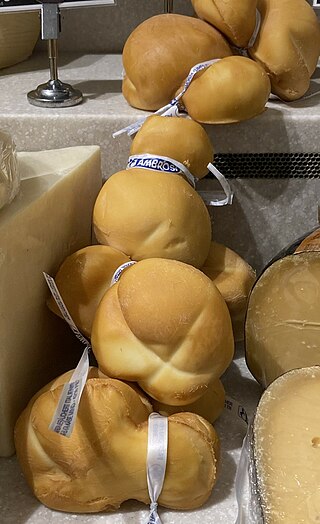| Place of origin | Italy |
|---|---|
| Region or state | |
Cacioricotta is a typical southern Italian cheese produced in the regions of Basilicata, Apulia and Calabria.
| Place of origin | Italy |
|---|---|
| Region or state | |
Cacioricotta is a typical southern Italian cheese produced in the regions of Basilicata, Apulia and Calabria.
Cacioricotta is produced with a "hybrid" method of preparation, following both the steps used in the production of ricotta as well as hard paste cheese. The cheese is usually made with sheep or goat milk, and more rarely with cow milk and water buffalo milk. [1]
To manufacture the cheese filtered milk is heated up until it reaches its boiling point; the liquid is then left to cool until it reaches a temperature of 38–40°, rennet is then added. Due to the liquid reaching a temperature close to 90° whilst reaching its boiling point, curd, as well as casein and albumin, are integrated within the liquid, unlike ricotta where whey becomes a by-product. [2] [3]
Cacioricotta is recognised as a prodotto agroalimentare tradizionale (PAT), and has the following variants in these Italian regions:

Mozzarella is a semi-soft non-aged cheese prepared by the pasta filata ('stretched-curd') method with origins from southern Italy.

Pecorino romano is a hard, salty Italian cheese made with sheep's milk that is often used for grating over pasta or other dishes. The name pecorino simply means 'ovine' or 'of sheep' in Italian; the name of the cheese, although protected, is a description rather than a brand: [formaggio] pecorino romano simply means 'sheep's [cheese] of Rome'.

Casu martzu, sometimes spelled casu marzu, and also called casu modde, casu cundídu and casu fràzigu in Sardinian, is a traditional Sardinian sheep milk cheese that contains live insect larvae (maggots).

Caciocavallo is a type of pasta filata ('stretched-curd') cheese made out of sheep's or cow's milk. It is produced throughout southern Italy, particularly in the Apennine Mountains and in the Gargano peninsula. Shaped like a teardrop, it is similar in taste to the aged southern Italian provolone cheese, with a hard edible rind.

Asiago is a cow's milk cheese, first produced in Asiago in Italy, that can assume different textures according to its aging, from smooth for the fresh Asiago to a crumbly texture for the aged cheese. The aged cheese is often grated in salads, soups, pastas, and sauces while the fresh Asiago is sliced to prepare panini or sandwiches; it can also be melted on a variety of dishes and cantaloupe. It is classified as a Swiss-type or Alpine cheese.

Ricotta is an Italian whey cheese made from sheep, cow, goat, or Italian water buffalo milk whey left over from the production of other cheeses. Like other whey cheeses, it is made by coagulating the proteins that remain after the casein has been used to make cheese, notably albumin and globulin.

Soppressata is an Italian dry salume. Although there are many variations, two principal types are made: a cured dry sausage typical of Basilicata, Apulia, and Calabria, and a very different uncured salami, made in Tuscany and Liguria. It is still part of southern Italian cultural heritage that local people slaughter the pig themselves and use it all, with nothing going to waste, using some parts to make cured meats, including soppressata. It is sometimes prepared using ham.

Scamorza is a southern Italian cow's milk cheese. It can also be made from other milks, but that is less common. It is a pasta filata ('stretched-curd') cheese, in which the fresh curd matures in its own whey for several hours to allow acidity to develop through the conversion of lactose to lactic acid. Artisanal cheese makers generally form the cheese into a round shape, and then tie a string around the mass one third of the distance from the top, and hang it to dry. The resulting shape is pear-like. This is sometimes referred to as "strangling" the cheese. The cheese is usually white unless smoked. When smoked, the color is almond with a lighter interior.

Brös is a Piedmontese and Ligurian preparation of cheese and grappa which, in former centuries, was typical of the peasant cuisine of the Upper Langa and West Liguria. Its pungent flavour gave rise to the proverb “Only love is stronger than Brös”. It has been conjectured that its name derives from Bresse.

The pallone di Gravina is a firm, semi-hard, cow's milk cheese from the regions of Basilicata and Apulia, in south-east Italy. It is made in the pasta filata style weighing between 1.5 and 2.5 kg, in a pear-like shape, ball or balloon (pallone), and was traditionally produced in the area of the city of Gravina, in the Murgia area of the province of Bari. Today, however, production is centred on the province of Matera.

Stracciata is a fresh pasta filata cheese produced in Italy. Stracciata is formed into flat strips of about 4–5 cm wide, 1 cm thick and folded in on itself in a uniform manner or woven wire, made with cow's milk. The name stracciata means "tattered" in Italian.
The Aspromonte or Capra dell'Aspromonte is an indigenous breed of domestic goat from the mountain massif of the Aspromonte, in the province of Reggio Calabria in Calabria in southern Italy, for which it is named. It is raised only in the province of Reggio Calabria, mainly in the Aspromonte, in the Altipiano dello Zomaro to the north-east, and in the Ionian coastal areas of the province, and particularly in areas of Grecanic culture. While the breed is thought to originate on the Aspromonte, it may have been influenced by the various other goat breeds, including the Abyssinian goat, the Maltese, and a type known as "Tibetan" with long silky hair, whose importation to Calabria in the early twentieth century is well documented.

Ricotta forte is a very traditional soft cheese of Basilicata and Apulia, in southeastern Italy. It is creamy, spicy and slightly bitter.
Prescinsêua is a variety of cheese typical of the province of Genoa in the region of Liguria in Italy. In Italian it is also referred to as quagliata or cagliata. It is recognised by P.A.T. .
Ricotta di fuscella is a fresh cow's-milk cheese made in the Campania region of Italy. It is recognized as a PAT product.

The cuisine of Basilicata, or Lucanian cuisine, is the cuisine of the Basilicata region of Italy. It is mainly based on the use of pork and sheep meat, legumes, cereals and vegetables, with the addition of aromas such as hot peppers, powdered raw peppers and horseradish. The local gastronomy is, for historical-cultural reasons, typically peasant, based on simple recipes and on the culture of reuse, in particular of meat and bread.
Provola silana is a variety of cheese typical of the Sila area, in the Italian region of Calabria.